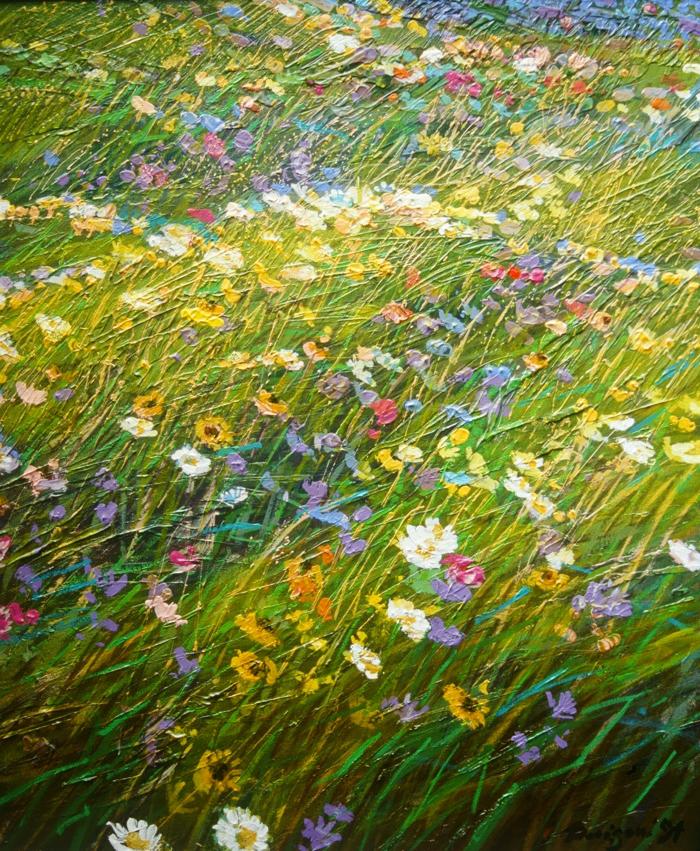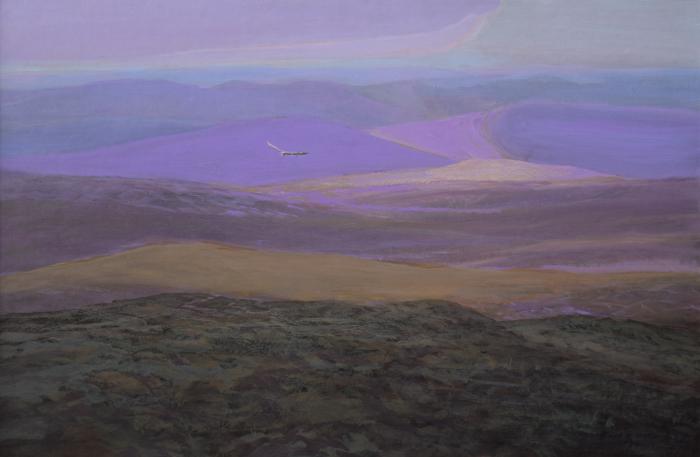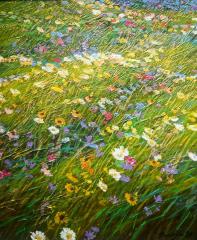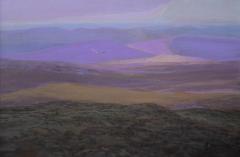Meanwhile, his vision continued to worsen. “He came back in 1993, eleven years later,” Dr. Gerbens says, and he was no longer wearing glasses. ‘Why wear glasses if they’re not helping?’ he said. ‘Why put these things on my face?’ His vision was 20/200. He was legally blind.”
Gerbens recalls: “In the end I just became an encourager. He would call me and say, ‘I woke up this morning and it’s worse, Larry. Can I just come in and talk?’
“I knew what he had. I knew I really couldn’t do anything for him. So he’d come in and talk. Two statements keep coming back to me are: ‘If I can’t paint, I’ll die.’ And in a lighter moment, ‘I’m going to paint until I get pigment on the tip of my nose,’ meaning that he had to get that close to the canvas’” (Dornbush/Zandstra Interview with Jon McDonald, 10-26-12).
Jon McDonald maintains that the creative ability to paint was so deeply ingrained in Armand that he was somehow able to carry on and adapt. His paintings, always vibrant, continued to stay alive as he came to rely more on instinct and draw on that memory stocked up in brush strokes. Larry Gerbens comments that he’s not using his eyes so much as he’s using the experience of his mind in his painting.
While he might not have been able to drive or find food on his plate at luncheons with the West Michigan Eight, Armand was still painting masterworks, which surprised McDonald. “They [his current paintings] were still looking good. It just sort of evolved. I remember we went out to see his work at the farm, and I knew his eyesight was really poor and when I looked at a painting I said, ‘When did you do that?’
“‘I just finished it,’ he replied.”
McDonald was stunned. “Armand was one of the few pure artists I know. That’s all he thought about. That’s what he was. I think he did a lot of it just by instinct. He knew what to do, and you know, he had a little vision on the sides, and he would pick up what he wanted and adjust it. He really didn’t miss a beat because he knew how to draw so well. He knew the shape.”
Regarding any changes during that time, American painter Paul Collins, who considers Armand his mentor, said, “When you see his work now you’d never know that he has failing eyesight. You’d think he’s just taking off in another direction. The barn now is a little more spiritual than it is detailish. You can see that over a period of time how his work has changed and come back. He never leaves his basic foundation of being honest about how he feels about it and portraying it to people.”
Armand made this observation, “One of the turning points in my artistic life was a day long ago when I picked up a feather lying on the ground and couldn’t recognize the type of bird it was from. For that very reason the impact of it was all the more pure in my eyes. Looking at the colored bars on the feather I said to myself, ‘What a beautiful abstract design.’ Not knowing what kind of bird it was helped me to see it more objectively. . . Even if I had a perfect photograph of it, of a given species with all the colors and design and everything, I couldn't -- I could in an abstract way abbreviate the pattern of it, the basic color patterns, but I couldn't go into detail. No, I just can’t” (Dornbush /Zandstra Interview, 7-10-02).
As his eyesight dimmed, Armand began to draw more on his other senses and used tools to accommodate. For instance, when his depth perception was gone, when he couldn’t tell when the brush was going to touch the canvas, he would use something to brace his hand as it touched the canvas.
His daughter Chantal recalls, “He couldn’t do portraits anymore. He still tried to do a few portraits and a couple were successful but most of them . . . people weren’t happy about them. . . and that was really hard on my mom, because she didn’t like to criticize and tell him that anything was not quite correct. She didn’t want to hurt him. She was always very tender.”
Chantal also observed that his colors became brighter and more vivid to compensate for his dimming eyesight. It took him longer to paint. And the pile of discards grew. She also believed that many of his later paintings were “intuitive.” Instead of his eyes he “was using his brain and his heart and his memory.”
So, with failing eyesight how did he know what colors and what paints to use? Chantal said, “When he was out in the studio he had them all lined up right on the table. He was very much in control when he was out there because nobody ever went out there to the ‘Pavilion of Intelligence.’ [Here she is referring to the backyard chicken coop that he converted to his art studio]. He had these little cups that he would mix his paints into and he had little colors on top of those, so he knew.”
She explained, “He would test it, maybe on his easel, because there’s so much paint on the easel, over an inch of buildup. Sometimes he’d call me in there and ask me to remind him what colors were what.” She imitated him in a low, gruff voice. “‘Can you read these for me? Read these’, and then ‘okay, okay, okay.’ He had two tables. On one he’d have his more immediate things. On the other he kept the bulk of his materials.”
She continued: “Although he was able to paint some amazing abstracts and creative paintings, I think he really had a desire and drive to get back to what he used to do. So he would try, and get frustrated, and have a lot of half-finished paintings that just didn’t go anywhere because he was unhappy with them. Around that time he started having me help him with backgrounds.
“He did all these lines and then he had me fill in the squares. He would mix up the paint, put them in little buckets for me. He built a little easel for me and I had it in my bedroom upstairs, so I could just sit there and paint. He paid me by the hour when I was a student and that was really helpful.”
Along with his fading vision, his hands had become painfully arthritic. Not surprisingly, he also battled depression. Faced with such formidable obstacles, you’d think his ability to paint would decline dramatically. And yet it appeared that, along with his years of experience, he now was able to draw on his well-stocked painter’s memory.
This continued during the time Chantal was in nurses’ training. “Then there was a gap, when I had other work. At that time he kind of got into his own thing. A few years later he needed more help from me—reinforcing his lines because, after drawing a line for an image or something, he couldn’t see it anymore. So he had me reinforce it with dark…. I don’t know how he drew the line in the first place but he did. But he couldn’t repeat what he was doing.
“It was really exciting to know that I was doing this, the background of his work, because his work has so many layers and mine was the very bones, the foundation. And on a lot of those paintings they show through.”
Without a doubt, Chantal helped her father continue to render his presence in that “pavilion of intelligence” (Zandstra Interview with Chantal Merizon/VanHeest, 11-19-12 ).






